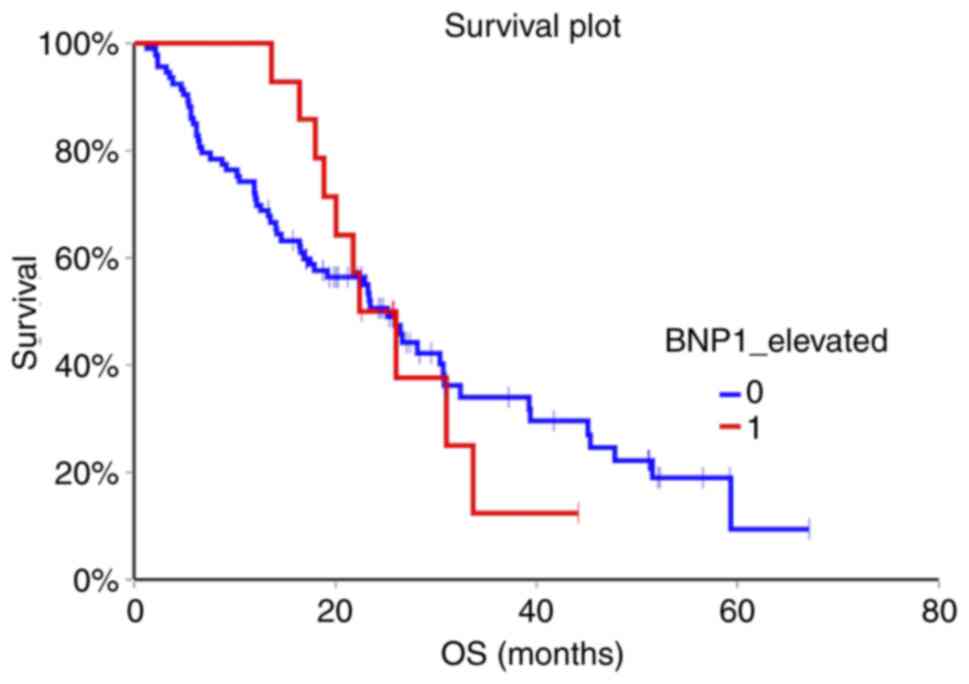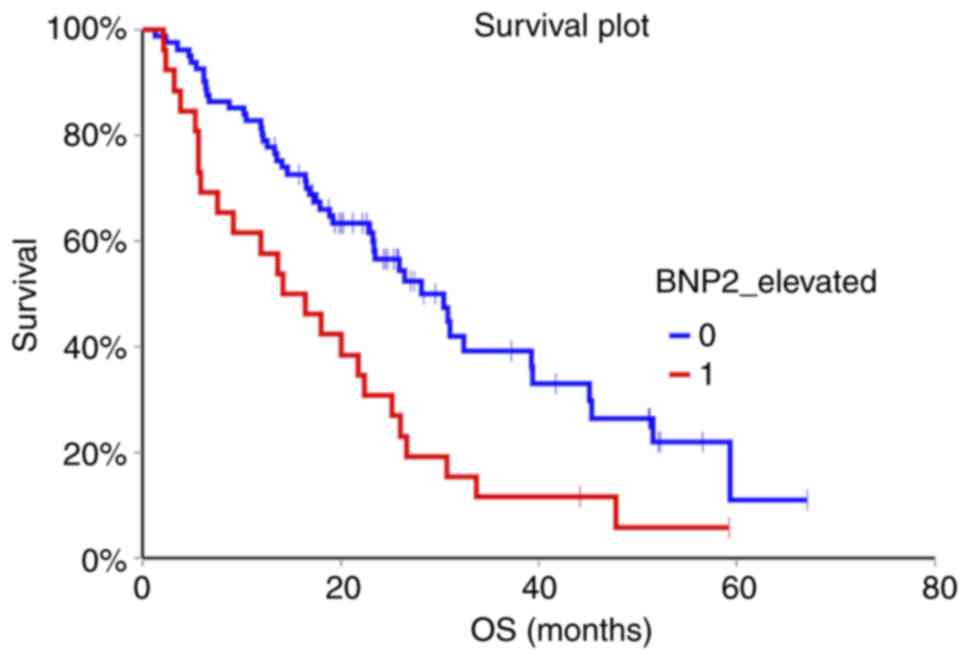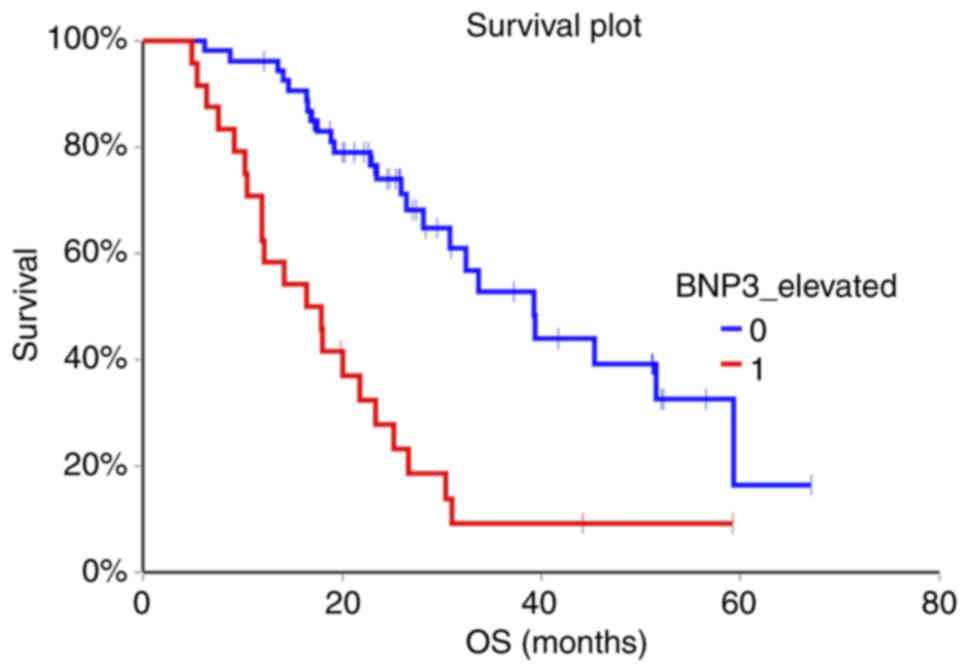|
1
|
Poprach A, Petráková K, Vyskocil J, Lakomý
R, Nemecek R, Kocák I, Kocáková I and Vyzula R: Cardiotoxicity of
drugs used in oncology. Klin Onkol. 21:288–293. 2008.(In Czech).
PubMed/NCBI
|
|
2
|
Kinova S, Hulin I, et al: Internal
medicine. Prolitera, ISBN:. 9788097025397:2802013.
|
|
3
|
Bando S, Soeki T, Matsuura T, Tobiume T,
Ise T, Kusunose K, Yamaguchi K, Yagi S, Fukuda D, Iwase T, et al:
Plasma brain natriuretic peptide levels are elevated in patients
with cancer. PLoS One. 12:e01786072012. View Article : Google Scholar
|
|
4
|
Mladosievicova B, et al: Cardiooncology.
Grada, ISBN:. 9788024748382:1332014.
|
|
5
|
Goncalvescová E: Merit of natriuretic
peptides for diagnosis, prognosis, management and therapy of heart
failure. Int Med Practice. 10:428–431. 2006.
|
|
6
|
Pudil R, Mueller C, Čelutkienė J,
Henriksen PA, Lenihan D, Dent S, Barac A, Stanway S, Moslehi J,
Suter TM, et al: Role of serum biomarkers in cancer patients
receiving cardiotoxic cancer therapies: A position statement from
the cardio-oncology study group of the heart failure association
and the cardio-oncology council of the European society of
cardiology. Eur J Heart Fail. 22:1966–1983. 2020. View Article : Google Scholar : PubMed/NCBI
|
|
7
|
Oral I: Brain natriuretic peptide as
prognostic marker of two-year survival in patients with heart
failure in a long-term dialysis programme. Interventional
Cardiology. 3:112–115. 2006.
|
|
8
|
Kamai T, Tokura Y, Uematsu T, Sakamoto K,
Suzuki I, Takei K, Narimatsu T, Kambara T, Yuki H, Betsunoh H, et
al: Elevated serum levels of cardiovascular biomarkers are
associated with progression of renal cancer. Open Heart.
5:e0006662018. View Article : Google Scholar : PubMed/NCBI
|
|
9
|
Aujolett N, Meyer M, Cailliod R, Combier
F, Coignet Y, Campard S, Facy O, Bernard A and Girard C: High
N-terminal Pro-B type natriuretic peptide: A biomarker of lung
cancer? Clin Lung Cancer. 11:341–345. 2010. View Article : Google Scholar : PubMed/NCBI
|
|
10
|
Pavo N, Raderer M, Hülsmann M, Neuhold S,
Adlbrecht C, Strunk G, Goliasch G, Gisslinger H, Steger GG, Hejna
M, et al: Cardiovascular biomarkers in pacients with cancer and
their association with all-cause mortality. Heart. 101:1874–1880.
2015. View Article : Google Scholar : PubMed/NCBI
|
|
11
|
Popat J, Rivero A, Pratap P and Guglin M:
What is causing extremely elevated amino terminal brain natriuretic
peptide in cancer patients. Congest Heart Fail. 19:143–148. 2013.
View Article : Google Scholar : PubMed/NCBI
|
|
12
|
Manimala NJ, Frost CD, Lane ML, Higuera M,
Beg R and Vesely DL: Cardiac hormones target nuclear oncogenes
c-Fos and c-Jun in carcinoma cells. Eur J Clin Invest.
43:1156–1162. 2013.PubMed/NCBI
|
|
13
|
Tuňón J, Higueras J, Tarín N, Cristóbal C,
Lorenzo O, Blanco-Colio L, Martín-Ventura JL, Huelmos A, Alonso J,
Aceña A, et al: N-terminal pro-brain natriuretic peptide is
associated with a future diagnosis of cancer in patients with
coronary artery disease. PLoS One. 10:e01267412015. View Article : Google Scholar : PubMed/NCBI
|
|
14
|
Zhang J, Zhao Z, Zu C, Hu H, Shen H, Zhang
M and Wang J: Atrial natriuretic peptide modulates the
proliferation of human gastric cancer cells via KCNQ1 expression.
Oncol Lett. 6:407–414. 2013. View Article : Google Scholar : PubMed/NCBI
|
|
15
|
Advani P, Hoyne J, Moreno–Aspita A, Dubin
M, Brock S, Harlow C, Chumsri S, Suter T and Blackshear JL:
High-senzitive troponin T and NT-proBNP kinetics in breast cancer
chemotherapy. Chemotherapy. 62:334–338. 2017. View Article : Google Scholar : PubMed/NCBI
|
|
16
|
Mladosievicova B, Urbanova D, Radvanska E,
Slavkovsky P and Simkova I: Role of NT-proBNP in detection of
myocardial damage in childhood leukemia survivors treated with and
without anthracyclines. J Exp Clin Cancer Res. 31:862012.
View Article : Google Scholar : PubMed/NCBI
|
|
17
|
Michel L, Rassaf T and Totzeck M:
Biomarkers for detection of apparent and subclinical cancer
therapy-related cardiotoxicity. J Thorac Dis. 10:S4282–S4295. 2018.
View Article : Google Scholar : PubMed/NCBI
|
|
18
|
Cao Z, Jia Y and Zhu B: BNP and NT-proBNP
as diagnostic biomarkers for cardiac dysfunction in both clinical
and forensic medicine. Int J Mol Sci. 20:18202019. View Article : Google Scholar : PubMed/NCBI
|
|
19
|
Cingelová S: Cardiotoxicity of breast
cancer adjuvant treatment. Klinicka onkologie J. 20:330–334.
2007.
|
|
20
|
Romano S, Fratini S, Ricevuto E,
Procaccini V, Stifano G, Mancini M, Di Mauro M, Ficorella C and
Penco M: NT-proBNP and antracycline-induced cardiotoxicity. Br J
Cancer. 105:1663–1668. 2011. View Article : Google Scholar : PubMed/NCBI
|
|
21
|
Papazisis K, Kontovinis LF, Papandreou CN,
Kouvatseas G, Lafaras C, Antonakis E, Christopoulou M, Andreadis C,
Mouratidou D and Kortsaris AH: Brain natriuretic peptic precursor
(NT-proBNP) level predict for clinical benefit to sunitinib
treatment in patients with metastatic renal cell carcinoma. BMC
Cancer. 10:4892010. View Article : Google Scholar : PubMed/NCBI
|
|
22
|
Rossner D, Knobloch K, Lichtinghagen R,
Lichtenberg A, Kuehnle H and Lück HJ: NT-proBNP and Ca 125 as
potential markers of mortality during long-term immunotherapy with
trastuzumab in HER-2-possitive metastatic breast cancer. J Clin
Oncol. 22:804. 2014. View Article : Google Scholar
|
|
23
|
Ruggieri F, Noris A, Beretta L, Mortini P
and Gemma M: Serum B-type natriuretic peptide is affected by
neoplastic edema in patients with brain tumor. World Neurosurg.
85:193–196. 2016. View Article : Google Scholar : PubMed/NCBI
|
|
24
|
Bunevicius A, Deltuva V, Laws ER, Iervasi
G, Tamsauskas A and Bunevicius R: Preoperative N-terminal
pro-B-type natriuretic peptide concentration and prognosis of brain
tumor patients: A 5-year follow up study. Sci Rep. 7:147752017.
View Article : Google Scholar : PubMed/NCBI
|

















